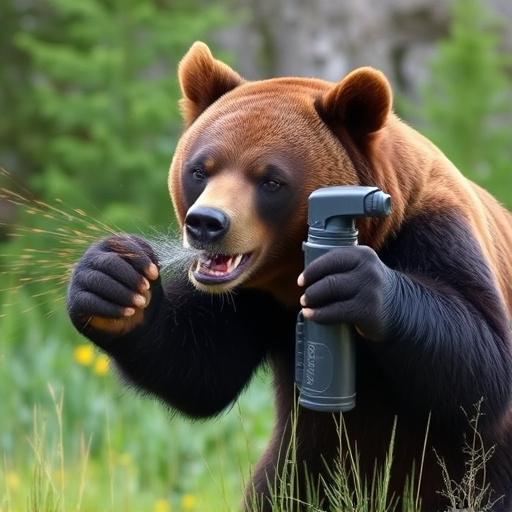Bear spray, an essential tool in bear country, disrupts bears' senses with capsicum chemicals, offering a maximum distance coverage of 20-35 feet. Effectiveness hinges on nozzle design, capsaicin concentration, and weather conditions. For optimal results, users should aim at the bear's face, follow instructions precisely, and consider other preventive measures like noise makers and habitat avoidance to maximize safety in bear encounters.
“Uncovering the power of bear spray: a crucial tool for wilderness safety. Bear encounters can be frightening, and understanding how bear spray works is essential for hikers and outdoor enthusiasts. This article explores the effectiveness of bear spray against charging bears, delving into its mechanism and limitations. We’ll uncover critical factors influencing the spray’s maximum distance coverage, providing insights to ensure safe interactions with these majestic creatures. Get ready to navigate the wilderness with confidence.”
- Understanding Bear Spray: How It Works and Its Limitations
- Factors Affecting Bear Spray Maximum Distance Coverage
- Effective Use of Bear Spray Against Charging Bears
Understanding Bear Spray: How It Works and Its Limitations
Bear spray, also known as bear repellent, is a popular tool for individuals venturing into bear country. It’s designed to create a barrier between you and an attacking bear by releasing a potent mix of capsicum (a type of chili pepper) and other chemicals when sprayed. The active ingredient irritates the bear’s eyes, nose, and throat, causing it to recoil and retreat. This spray is often recommended for hikers, campers, and hunters as a non-lethal defense mechanism against both black and grizzly bears.
While incredibly effective at halting an attack, bear spray has its limitations. The maximum distance coverage varies between products, typically ranging from 20 to 35 feet (6 to 10 meters). Wind direction and speed can significantly reduce the effective range, making it crucial for users to understand these factors during use. Additionally, proper application technique is essential; spraying too high or too low can result in reduced effectiveness. Despite its reliability in most situations, bear spray should be used as a last resort, with other preventive measures like noise-making devices and avoiding known bear habitats being prioritized first.
Factors Affecting Bear Spray Maximum Distance Coverage
The effectiveness of bear spray in stopping a charging bear depends on several factors that influence its maximum distance coverage. One key consideration is the can’s nozzle design; a narrow stream or precision spray pattern allows for greater control and accuracy at closer ranges, while a broader spray might cover more area but could be less precise. The concentration of capsaicin, the active ingredient in bear spray, also plays a role in its impact distance. Higher concentrations can provide better results even at longer distances.
Weather conditions significantly affect bear spray performance. Wind, in particular, can alter the trajectory and range of the spray. A headwind may enhance coverage by carrying the spray towards the target, while a tailwind could reduce effective distance. Temperature and humidity also come into play; extreme heat or cold can impact the spray’s vaporization rate and dispersion, potentially affecting its overall effectiveness.
Effective Use of Bear Spray Against Charging Bears
Bear spray is an effective deterrent against charging bears, but its success depends on proper usage. To maximize bear spray’s distance coverage, users should aim for the face and eyes of the approaching bear. This direct targeting ensures the spray reaches sensitive areas, causing the bear to pause, retreat, or even temporarily incapacitate it.
When deploying bear spray, it’s crucial to follow instructions carefully. Users should hold the can upright, shake it thoroughly before use, and spray from a safe distance—typically recommended as 20-30 feet (6-9 meters). This ensures that the spray reaches the bear effectively while maintaining user safety.
Bear spray remains an effective deterrent against charging bears, provided users understand its proper application. The optimal range for bear spray is approximately 20-30 feet, but this can vary based on factors like weather conditions and the bear’s behavior. When used correctly, a single blast from a bear spray can discourage aggressive bears and provide valuable time to escape. However, it’s crucial to remember that no single tool is foolproof; awareness, prevention, and knowing when to run or fight back are still paramount in bear country.
